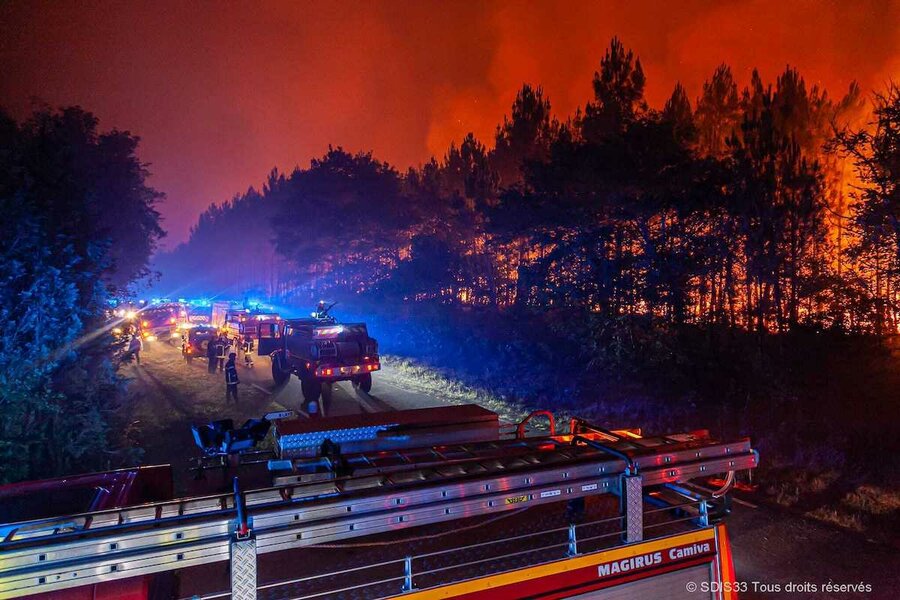Scorched Europe: Record high temps behind heat wave, wildfires
Loading...
| La Teste de Buch, France
A heat wave broiling Europe spilled northward Monday to Britain, where authorities warned of possible record temperatures, and fueled ferocious wildfires in France, which scrambled water-bombing planes and hundreds of firefighters to battle flames spreading through tinder-dry forests.
In Spain, two people were killed in blazes that the country’s prime minister linked to global warming, saying: “Climate change kills.”
In both France and Spain, fierce heat fueled the fires – part of a wall of high temperatures moving across Europe, touching even places like Britain, where officials have issued the first-ever extreme heat warning. The country’s weather service forecast that the record high of 38.7 degrees Celsius (101.7 degrees Fahrenheit), set in 2019, could be shattered.
“Forty-one isn’t off the cards,” said Met Office CEO Penelope Endersby. “We’ve even got some 43s in the model, but we’re hoping it won’t be as high as that.”
French forecasters also warned of possible record temperatures as swirling hot winds complicated firefighting efforts in the country’s southwest.
Authorities there started evacuating more towns, moving out another 3,500 people at risk of finding themselves in the path of the raging flames that have already seared 140 square kilometers (54 square miles) of pine forests and other vegetation. That will take the number who have been forced out of their homes in the Gironde region to around 20,000 since the wildfires began July 12.
The regional fire service chief, Marc Vermeulen, described the burning forests as “a powder keg” and said tree trunks were shattering as flames consumed them, sending burning embers into the air and further spreading the blazes.
“The fire is literally exploding,” he said. “We’re facing extreme and exceptional circumstances.”
Three additional planes were sent to join six others already fighting the fires, scooping up seawater into their tanks and making repeated runs through dense clouds of smoke, the Interior Ministry said Sunday night.
More than 200 reinforcements headed to join the 1,500-strong force of firefighters battling night and day to contain the blazes in the Gironde, where flames neared prized vineyards and the Arcachon maritime basin famed for its oysters and beaches.
Spain, meanwhile, reported a second fatality in two days as it battled its own blazes. The body of a sheep farmer was found Monday in the same hilly area where a firefighter died a day earlier when he was trapped by flames in the northwestern Zamora province. More than 30 forest fires around Spain have forced the evacuation of thousands of people and blackened 220 square kilometers (85 square miles) of forest and scrub.
Heat waves and drought tied to climate change have made wildfires harder to fight. Scientists say climate change will continue to make weather more extreme and wildfires more frequent and destructive.
“Climate change kills,” Spanish Prime Minister Pedro Sánchez said Monday during a visit to the Extremadura region, where firefighters tackled three major blazes. “It kills people, it kills our ecosystems, and biodiversity.”
Teresa Ribera, Spain’s minister for ecological transition, described her country as “literally under fire” as she attended talks on climate change in Berlin.
She warned of “terrifying prospects still for the days to come” – after more than 10 days of temperatures over 40 C (104 F), cooling only moderately at night.
According to Spain’s Carlos III Institute, which records daily temperature-related fatalities, 237 deaths were attributed to high temperatures from July 10 to 14. That was compared to 25 heat-related deaths the previous week.
The heat wave in Spain is forecast to ease on Tuesday, but the respite will be brief as temperatures rise again on Wednesday, especially in the dry western Extremadura region.
In Portugal, much cooler weather Monday helped fire crews make progress against blazes. More than 600 firefighters attended four major fires in northern Portugal.
The story was reported by The Associated Press. AP journalist John Leicester reported from Le Pecq, France. Danica Kirka and Jill Lawless in London, Geir Moulson in Berlin, Raquel Redondo in Madrid, and Barry Hatton in Lisbon, Portugal, contributed to this report.







